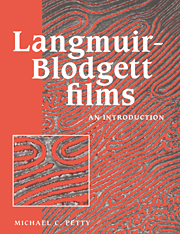3 - Film deposition
Published online by Cambridge University Press: 30 November 2009
Summary
Deposition principles
The Langmuir—Blodgett (LB) technique, first introduced by Irving Langmuir and applied extensively by Katharine Blodgett, involves the vertical movement of a solid substrate through the monolayer/air interface (Blodgett, 1934; Blodgett, 1935; Langmuir, 1920). Blodgett's and Langmuir's original papers contain a wealth of useful experimental advice and are still excellent starting points for anyone considering working in the area today (Blodgett, 1935; Blodgett and Langmuir, 1937).
The surface pressure and temperature of the monolayer are first controlled so that the organic film is in a condensed and stable state. For fatty acid type materials, deposition generally proceeds from either the L2′, LS or S phase (with surface pressures in the range 20–40 mN m-1 and temperatures 15–20°C). However, it is also possible to start from one of the other monolayer states. The molecular organization in the resulting LB film will depend on these initial conditions.
Figure 3.1 shows the commonest form of LB film deposition. The substrate is hydrophilic and the first monolayer is transferred, like a carpet, as the substrate is raised through the water. The substrate may therefore be placed in the subphase before the monolayer is spread. Subsequently, a monolayer is deposited on each traversal of the monolayer/air interface.
- Type
- Chapter
- Information
- Langmuir-Blodgett FilmsAn Introduction, pp. 39 - 64Publisher: Cambridge University PressPrint publication year: 1996
- 8
- Cited by



